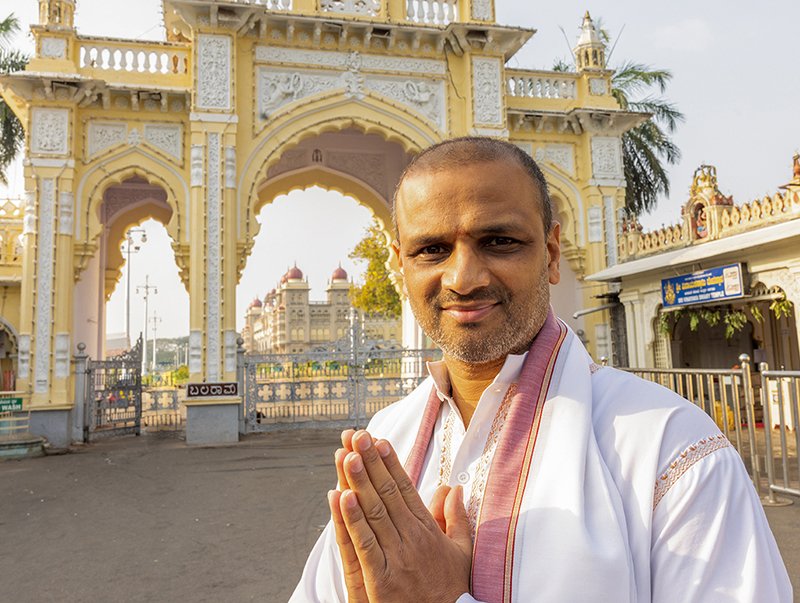The philosophy of yoga is drawn from the vast teachings of the Vedas, the texts that describe the unity or “one-ness” that underlies the phenomenal world. Much of the Vedas are also concerned with “dharma”—the actions or conduct that allow us to be in harmony in all of our relationships, both externally with the world and those around us, as well as internally with ourselves.
Yoga provides specific practices for this purpose: yamas (social observances) and niyamas (personal observances). Yama and niyama are the first two of ashtanga yoga’s eight limbs. When combined with āsana (the practice of postures) and prāṇāyāma (breathing techniques), they help to bring the mind and senses into a state of stable attention. This allows for progression in the later four limbs of yoga, which focus on attaining higher meditative states. Following yama and niyama is the foundation for a yoga practice that allows us to operate smoothly and easily in the world. It provides us with greater mental clarity, freeing up much of the energy that is otherwise wasted when we are out of sync with our physical, mental, and emotional surroundings.
Many people are familiar with the five yamas and five niyamas outlined in Patanjali’s Yoga Sutras, but other hatha yoga texts such as the Hatha Yoga Pradipika of Svātmarāma and the Yoga Yājñavalka include additional yamas and niyamas. These are also outlined in Krishnamacharya’s Yoga Makaranda, originally published in 1934.
Although the practice of the yamas will positively affect those around us, the main aim is for our internal transformation, which is essential for progression beyond the physical aspects of yoga practice. Additionally, by practicing the other limbs of ashtanga yoga, we will be able to bring greater perfection to each of the yamas, bringing greater clarity, peace, and joy in all our relationships. Below are six additional yamas not listed by Patanjali.
1. Kṣamā can be translated as patience or forgiveness. When we forgive, we relinquish the hold that past experience has on the mind and emotions. We are no longer bound by that experience. Kṣamā allows us to understand our situation from a broader perspective and to live more easily in the present moment.
Related: The Unique Power of Forgiveness on Your Health
2. Dhṛtiḥ means holding, seizing, keeping, supporting, firmness, constancy, resolution, will, or command. It can also have the meaning of satisfaction, contentment, or joy. In order to find success in any path, it is necessary to have a firm and unwavering conviction in what we do. When that steadfastness also has as an essence of satisfaction and contentment in the chosen path, the chances of maintaining our conviction, even in the face of obstacles, increase many times. Although dhṛtiḥ is not included in Patanjali’s list of yamas, he alludes to both its aspects in sūtra 1:14 when he states: “sātu dīrgha kāla nairantarya satkāra ādara āsevito dṛḍabhūmiḥ (practice becomes firmly established when it done for a long time, without interruption and with devotion and respect/enthusiasm).”
3. Dayā is sympathy or compassion. Being truly compassionate requires looking deeply into the hearts of others and trying to feel their experiences first-hand. We should try to see ourselves in others, and others within ourselves. Those great yogis who recognize that we are all an expression of the same consciousness and who experience unity within all beings are a perfect example of dayā. Patanjali’s sūtras on pratipakṣabhāvanam allude to dayā when he explains the importance of taking an opposing viewpoint in order to counteract our negative thoughts (vitarkas) and emotions.
4. Ārjava means straight, honest, sincere, or straightforward. We practice ārjava by aligning thought, speech, and action into one. The more we practice yoga and follow dharma, the more easily this process comes about. Ārjava is also described as meekness or humility. The mantra “idam na mama,” meaning, “This is not mine,” is uttered after making offerings during Vedic ceremonies. We should not gloat and say, ”Look what I have done,” but relinquish our ownership of any good results. Another smṛti text says, ”dharmaḥ kṣarati kīrtanāt,” meaning, “A virtue is spent by being made known through one’s own lips.” The attitude of a yogi should be that what we do is done happily for the good of all, and not for the purpose of recognition.
Related: The Power of Selfless Service
5. Mitāhāra means that one should not overeat, instead eating only the amount and types of food necessary to maintain good health and which are supportive of our sādhana (practice). Food should be simple, pure, and nourishing, but it is also very important not to become overly obsessed with diet. Food is sacred, it should be received with an attitude of reverence and thankfulness, and it should not be wasted. Regularity in eating is also very helpful for yoga practice. Consider the following śloka, which is mentioned as being quoted by Śrīdhara Swāmi in the Bhagavata Purana (Gita Press 1971): “dvau bhāgau pūrayedannaistoyenaikaṃ prapūrayet mārutasya pracārārthaṃ caturthamavaśeṣayet” (or “One should fill two-quarters of one’s belly with [articles of] food and one quarter with water. The fourth should be kept empty for the free passage of air”).
6. Śauca is cleanliness. External (bahir) or physical cleanliness refers not only to the body but also the surrounding environment, while internal (antara) cleanliness refers to a state of mental purity. Through external cleanliness, we become aware that the body is in a continual state of decay, resulting in a level of detachment from the physical body. At the same time, internal cleanliness results in an increase in mental clarity, greater control of the senses, and a vision or awareness of one’s own ātman or Self, the source of purity from within. Although there is indifference to the physical body, we will desire to maintain it in as pure state as possible in order to allow the full expression of the ātman.
Patanjali lists śauca as a niyama rather than a yama. He notes that attention to śauca will bring about saumanasya, or a state of gladness or cheerfulness in the mind. Therefore we should be careful not to become obsessive or puritanical in śauca.











Comments (0)